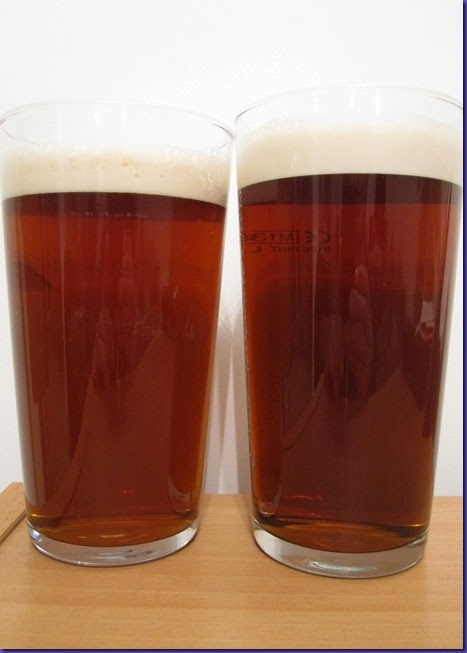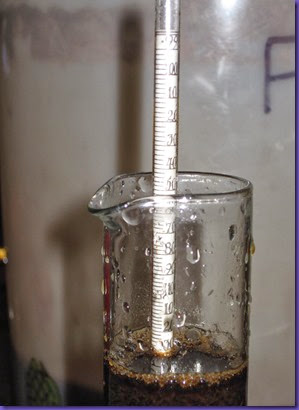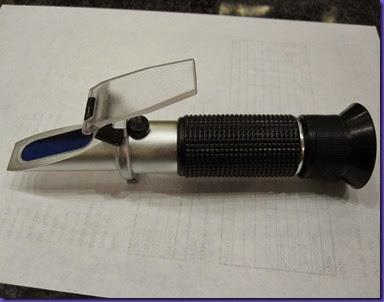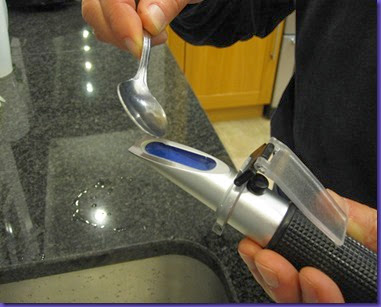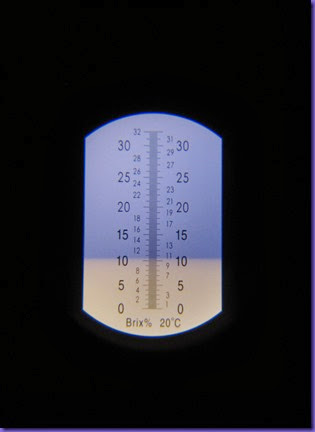I ordered a big batch of malt and hops from The Malt Miller recently. Whilst I was shopping I noticed that they have a whole range of experimental English hops. I’m not generally prone to impulse buying, but I make an exception where making beer is concerned. So I dropped three different ones in my shopping basket.
They were:
Archer – described as “apricot, peach and floral”
CF103 – described as “peppery, spicy and floral”
Bishop (CF114) – described as “earthy/honey”
So what’s with “English experimental hops”? England has a great heritage of hop growing and a good number of classic varieties that have been used for many years, such as Fuggles, Goldings, Challenger, Progress, Northdown and Bramling Cross. Why do the English growers feel they need to create new varieties?
The answer is down to the craft beer revolution. Many British craft breweries (and increasingly the larger breweries too) are using non-English hops which offer all sorts of different flavours. English hops give you floral, fruity and earthy flavours, but elsewhere you can get citrus, spicy, peppery, piney, resiny and herbal.
I think the international varieties are putting pressure on English growers to deliver a wider range of flavours. So they have been working on experimental varieties over recent years, and these are just starting to come to the market. Which is great for brewers – home brewers or commercial.
Anyway, back to my new experimental hops. The plan is to make a brew using each one, with a fairly simple malt bill so that we can focus on tasting the hops.
We made the first of these brews last Sunday, using the Bishop hops.
The recipe was as follows:
Grain bill
Maris Otter
4000g (83.3 | %) Biscuit malt 400g (8.3%) Torrified wheat 400g (8.3%) Hop Schedule First Gold (8.1% AA) 26g 60min (19 IBU) Bishop (4.5% AA) 25g 60min (10 IBU) | Bishop (4.5% AA) 25g 10min (4 IBU) Bishop (4.5% AA) 25g flamout Bishop (4.5% AA) 25g dry hop at end of fermentation, 5 days Water treatment: In 32 litres, 1.8 tsp gypsum Yeast: WYeast 1318 London Ale III (yeast cake from previous brew) Batch size: 23l Mash temp: 66C Mash time: 60 min Boil time: 60 min OG: 1.044 IBU: 33 Colour: 6.7 Lovibond, 8 SRM, 16 EBC Target FG: 1.012 Target ABV: 4.2% The brew went fine, except that we forgot to put in the irish moss! Irish moss is added to the wort during the boil to cause the proteins to precipitate out, improving clarity. We’ve forgotten it once or twice before and it makes a big difference. So we’re expecting a tasty but rather hazy beer. That doesn’t really matter to be honest because it won’t affect the flavour or aroma of the beer at all. We’re looking forward to trying Bishop’s earthy and honey flavours in a few weeks. 
I know this is supposed to be a beer blog, but it’s also my blog so I’ll abuse that from time to time. So here goes. Yesterday I went on a cheese making course at Hartingtons School of Food in Bakewell in the Peak District. I’ve been interested in the idea of making cheese for a while now, but the skills you need to get started are not something you can get from reading a book. I needed to SEE it. My wife came up with the great idea of enrolling me on a day course for my Christmas present. So, why cheese making? Well for me it’s just the same reason I am keen on making beer. It’s partly about the end product, but it’s largely about creating something from first principles that is complex, technical, challenging and takes a great deal of experience. Most people can turn their hand to cookery (although that’s perhaps a little unfair comparison because we all HAVE to eat). But who can make beer from grain and hops? Who can make cheese from milk and a few additives? It’s the challenge of understanding and undertaking those deeply complex processes that really gets me interested. So what was my day like? Well it started with a glorious drive across the peaks. Hartingtons School of Food is in the upper floor of a mill right by the river in the middle of Bakewell. It’s a wonderful setting. You can watch the ducks on the river whilst waiting for your milk to coagulate. The business is run by two lovely people called Julie and Chris. And the cheese making course was run by a lady called Chris Ashby who has a lifetime of experience of making cheese commercially. She was so full of knowledge and so happy to give it that I crammed as much into my brain as I could manage in one day. (Sorry to Chris for my hundreds of questions). It was a totally hands-on day pretty much from the start. In a single day you can’t spend ages going into scientific theory, so it was heating milk and adding drops of rennet right from the word go. We made three cheeses: a camembert, a lemon cheese and mozzarella. The camembert is the most technical cheese to make and over the day we got it to the stage where it was in a mould and ready to be taken home and cared for for 6 weeks before it is mature enough to eat. The lemon cheese is the complete opposite: dead simple to make and needs no special ingredients. It’s basically milk that is curdled with lemon juice and then strained. But it’s surprisingly effective. Once made you can spread it out and roll it like Boursin, with your preferred flavouring. The mozzarella was great fun and one I want to try with the kids. Once the milk has been separated and you have your curds, the whey is heated to 80C and small balls of curd are dipped in it for 30 seconds or so. This makes the curds go stringy and you can stretch and shape them into your preferred shape – balls, cheese sticks, plaits or whatever. We ate it with a barbecue tea when I got home, and the family scoffed it with gusto. So there’s a brief description of my first introduction to cheese making. I’m planning to buy a bit of equipment and try it again at home, so no doubt I’ll be abusing this beer blog again in the future. Cheshire Peaks Creamery anyone? 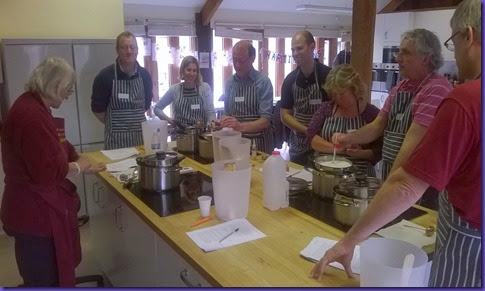
Heating the milk
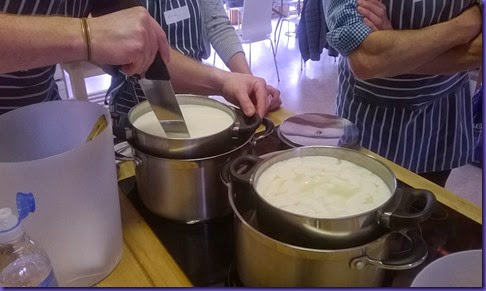
Cutting the curds
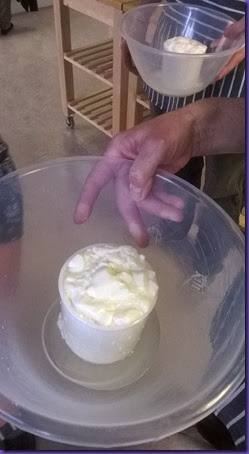
Curds in the mould
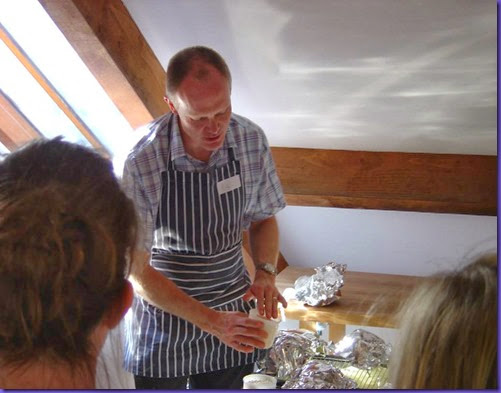
Turning the curds

Stretching mozzarella
I had a comment on my post recently regarding Mauribrew yeast, asking what the outcome was of the test. My response is sufficiently large that I thought I might as well post it as a new post for the benefit of other readers. The original post was here. We did two brews with Mauribrew yeast – one with 514 ale yeast, and one with 497 lager yeast. We used Mauribrew Ale 514 for a brew with First gold hops. My notes say that the flocculation and clarity were nowhere near as good as Fermentis Safale S-04 (our “standard” ale yeast). S-04 drops like a stone, whereas the yeast cake from the Mauribrew 514 was much dustier, and the clarity was not as good, even after being fined with Kwik Clear. Attenuation was 71% (1.045 down to 1.013) Taste-wise I don’t recall having any strong feelings about it. It was fine – it made a drinkable English ale. But to be honest since then I’ve gone back to S-04 because it clears better and still tastes good. We used the Mauribrew Lager Yeast 497 to make a Rauchbier. This turned out to be a stunning brew and we are still enjoying drinking it. But with it being such a forthright beer (36% smoked malt) it is a little hard to reach a totally clear view of what the yeast tasted like. Attenuation was again 71% (1.058 down to 1.017). I made a starter with the yeast, because one sachet just isn’t enough for lagers (same with Saflager S-23). The fermentation ran fine. I’d be happy enough to use it again, but given the choice I’d go back to S-23 because I know it can make a clean lager. In summary, I’d certainly use Mauribrew yeast again. I just tend to use Fermentis yeast because I know what I’m getting. Having said that, Fermentis yeast is getting ridiculously expensive these days (£3.95 for a sachet!?). Maybe I need to reconsider that… One final note – I saw in my local homebrew shop that they now have some Mangrove Jacks yeast. I’ve never heard of that or tried it before. Maybe time for another test… 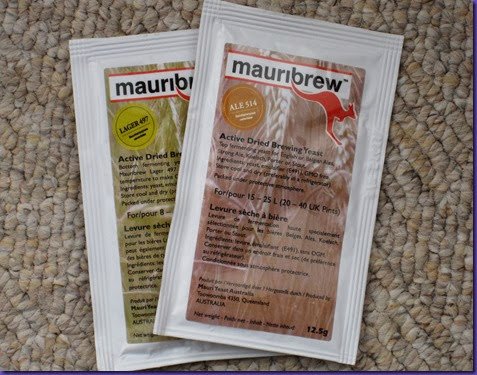
As I said in the last post, we’re trying to recreate Boddingtons – the classic cask Boddies from the Strangeways brewery. Last week we brewed a recipe from Orfy on Jim’s Beer Kit Forum. This week we brewed Seymour’s recipe which, interestingly, is completely different. It’s a much simpler malt bill and a much more complex set of hops. We used the same yeast that we used for the first brew (WYeast 1318 London Ale III). The great thing about doing brews back-to-back is you can just re-use the yeast cake from the last brew. So we simply racked the first brew into a keg and then pitched the new brew straight onto the yeast in the same fermenter. This works a treat and it saves you a whole load of washing and sanitising of the fermenter into the bargain. (In fact we’ve got plans for a third brew on this yeast cake, but more on that in a future post). So for the record, here’s the recipe for Boddingtons 2 (Seymour recipe). Thanks to both Orfy and Seymour! :-) Grain bill Maris Otter | 3400g (95 | %) Black Patent 70g (2%) Cane sugar 110g (3%) Hop Schedule Fuggles (5% AA) 24g 60min (11 IBU) EKG (5.4% AA) 17g 60min (9 IBU) WGV (6% AA) 16g 60min (10 IBU) Northern Brewer ( | 8.4% AA) 2 | g | 60min ( | 2 IBU) WGV (6% AA) 15g flameout EKG (5.4% AA) 10g flameout Northern Brewer ( | 8.4% AA) 10 | g | flameout | Water treatment: In 32 litres, 2.5 tsp gypsum and 1 tsp CaCl Yeast: WYeast 1318 London Ale III (yeast cake from previous brew) Batch size: 23l Mash temp: 66C Strike vol: 12l Mash time: 90 min Sparge vol: 16l Boil time: 60 min Finings: Irish Moss, 3g at 10 min OG: 1.036 IBU: 32 Colour: 11 Lovibond, 14 SRM, 28 EBC Target FG: 1.010 Target ABV: 3.5% 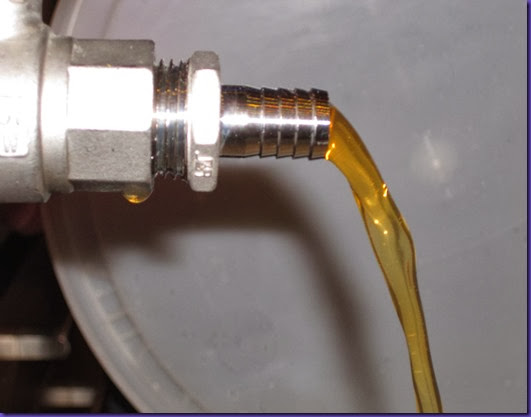
| 